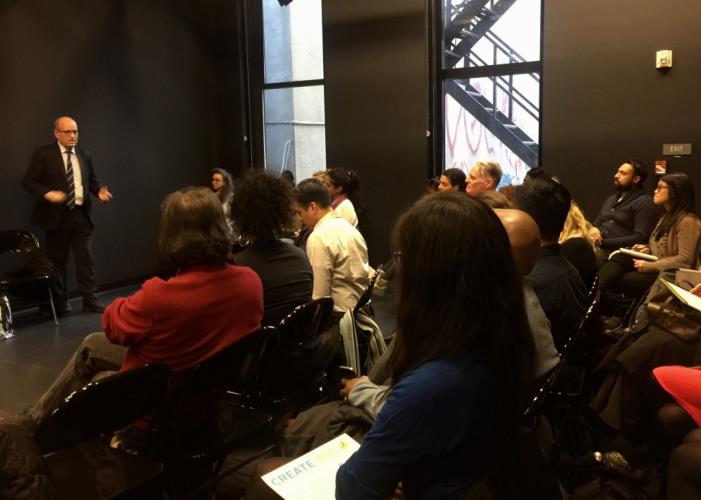Bachelor's degree with a double major in Chinese and Art in Peking University. Master of Art and Administration in New York University. She has served in the Macao Cultural Affairs Bureau, the New York City Department of Cultural Affairs and the Museum of Chinese in America, working as art administrator and curator. She is now working as an art educator and administrator in New York, as well as an independent curator and writer.

Creative NYC’s cultural planning seminar Photo courtesy of Tom Finkelpearl
Having lived in a vibrant, cultural city such as New York City for a year, I have discovered, much to my surprise, that the city’s cultural blueprint was not conceived until last year. It makes me consider whether a creative city can be planned. Can a cultural plan bring benefit or harm to the city’s creative development?
In September last year, the government of New York City announced that the Department of Cultural Affairs must submit its ten-year plan by this June for approval by the New York City Council. As a result, the Department immediately kicks off its research and planning, and begins a round of public consultation and activities, setting up a dedicated website “Creative New York” (CreativeNYC) for the project. In collaboration with cultural institutions and community groups, the Department organised over 400 different activities for the community, with 180,000 people taking part. These figures reveal the government’s emphasis on community involvement in planning and executing public policy.
Based on these activities and outreach, survey results were announced in May. The information collected reflects the cultural concerns of the public, and lends support to the government’s cultural plans. However, it is inevitable that the cultural practitioners who live in the city have their own grievances, as some of them protest that the public consultation has been conducted in haste, jeopardising the opportunities for smaller-scale cultural organisations to take on a bigger role. Another major concern among these practitioners is that there is a considerable number of cultural practitioners who are unaware of the government’s plans and consultation exercises. So the question is: does it reflect that some cultural practitioners are not paying attention to the policy agenda most relevant to them, or is the consultation exercise inadequate?
In my opinion, it is infeasible to expect a policy consultation exercise to achieve a 100% coverage on the population, particularly given the time constraint. We have to bear in mind that this is New York City’s first cultural blueprint, and that the consultation period is limited to a number of eight months. Since each responsible government official in charge will only serve for a number of years, we can only hope that those incumbent, capable officers have done what they can to steer the public consultation. For the case of New York in particular, a priority behind the drawing up of policy agenda, the public consultation design and subsequent data-collection, is to promote equality in cultural development. In face of Trump’s anti-immigrant policy and urge to eliminate funding support for municipal governments, it highlights New York City’s open-minded vision and attitude.
For New York City, cultural equality means that different groups in the community can enjoy the same rights to take part in cultural activities and claim their traditions. After all, New York City is a diverse society, with 60% of its population being non-Caucasians. For a long time, the cultural activities of these people are not accepted as part of the city’s cultural tradition, and therefore cannot secure funding from the government. The lack of resources makes it difficult for these community organisations to improve their scope and quality of work, and in turn makes it harder for them to procure more resources. The new cultural blueprint aims to re-allocate the city’s resources and to redefine culture in a more encompassing way.
A key person in re-engineering this change in New York City’s cultural policy is the Cultural Affairs Commissioner, Tom Finkelpearl, who worked previously as Director of Queens Museum, New York. As Director, Finkelpearl decided to install a table tennis table in the museum. Since there is a lot of Asian residents in the district, Finkelpearl established a personal relationship with the residents there by playing table tennis with them. Through the table tennis game, he successfully introduced these people to the museum and, as a result, the museum has become a great example of community outreach. Nowadays, in his new role, Finkelpearl invites the community to offer their feedback towards New York City’s cultural development through his weekly consultation sessions. He also seeks public opinions through hundreds of activities and survey exercises. At the same time, he continues with his “table tennis” policy in overseeing culture. Perhaps for Finkelpearl, cultural development is like a game of table tennis: it takes two to play a game. For Finkelpearl, he is willing to be the player who initiates it.